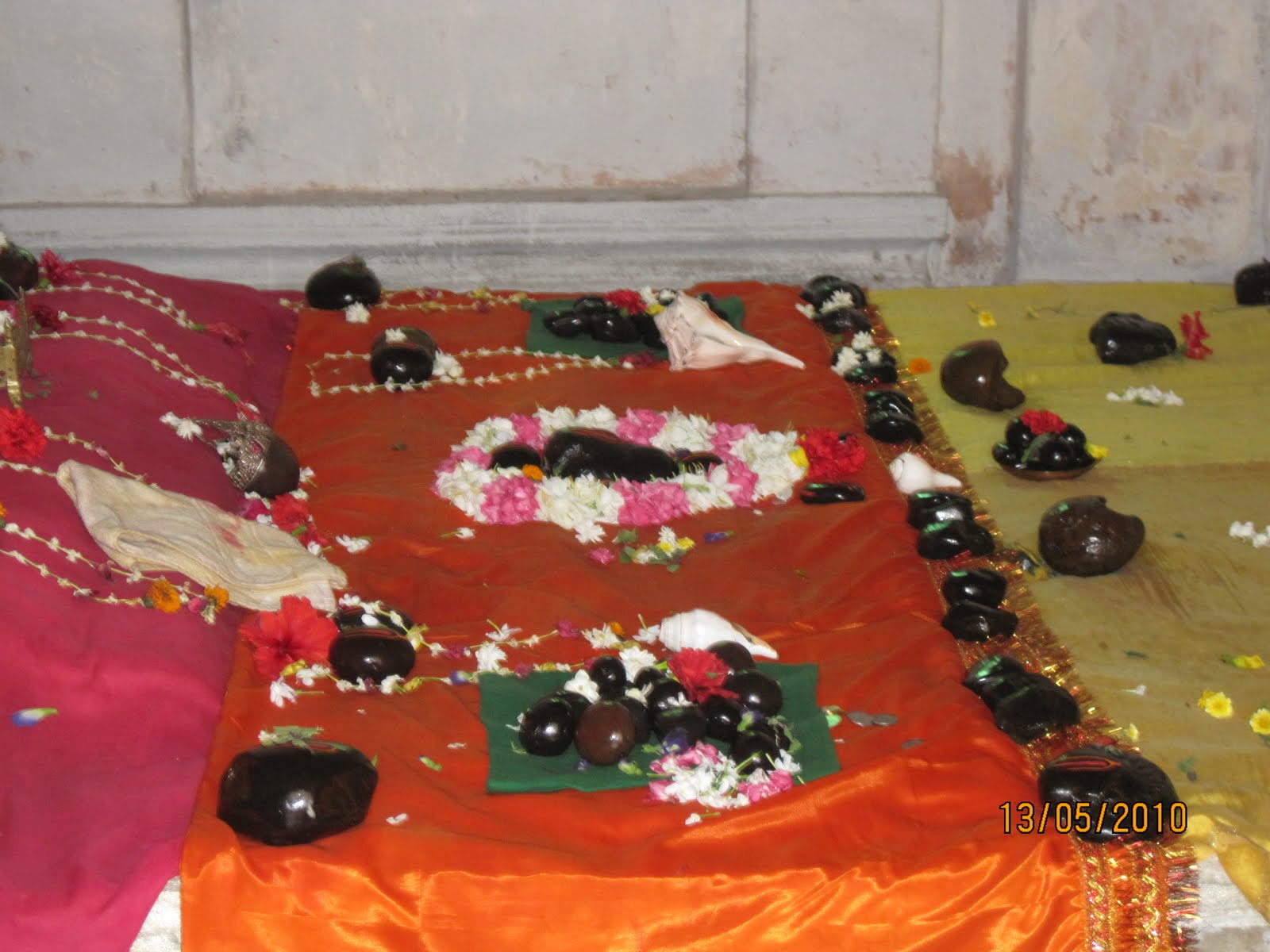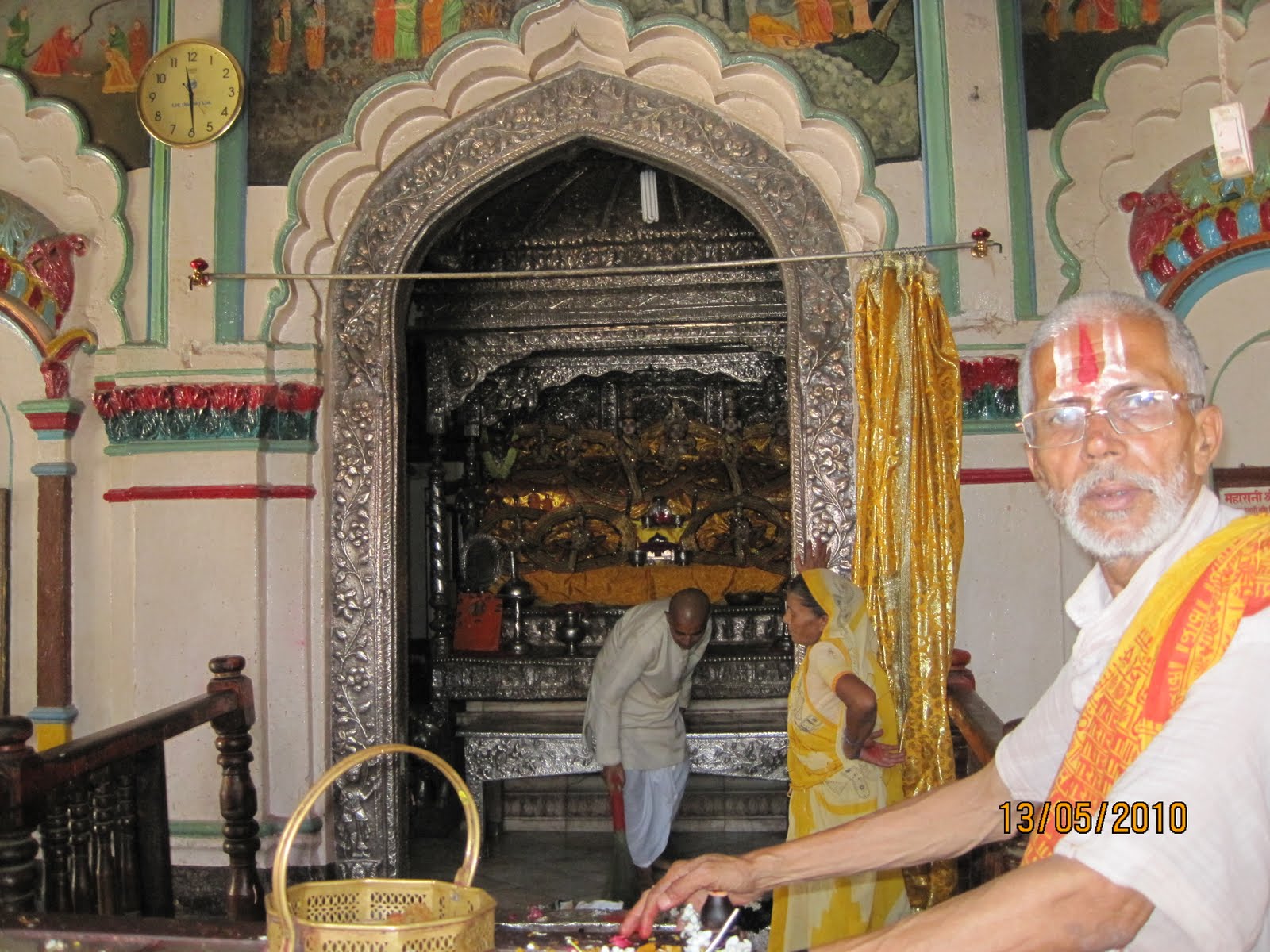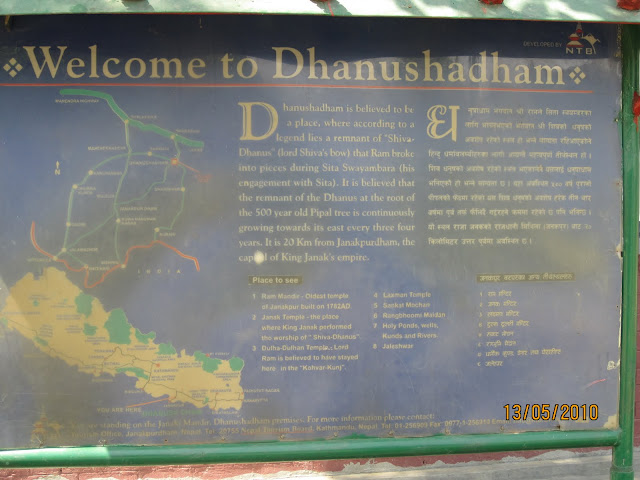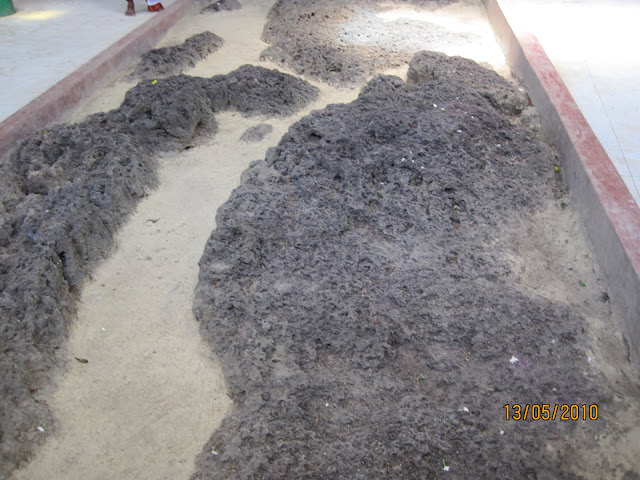
We have now reached Janaki Mandir/Temple and it is a wonder to watch. Janaki Mandir is apparently modern and is about 500 years old. The temple which is seen presently is the newly built and renovated one. The old temple got collapsed many years ago. Janaki Mandir is one of the finest pieces of architecture in Nepal, built in extravagant baroque Mughal style with exquisite bright white marbles. There is a huge courtyard (mutram) in the temple, which is strikingly handsome with shining marble stones. One can find many small sannidhis, when we go around the temple. One such sannidhi is found backside of the temple consisting Lakhs of Salagrama-silas (sacred black stones) which were worshipped by King Janaka everyday. Having darshan of those Salagramam is a feast to us, even for people without bhakthi it will bring bhakthi in them. The temple priest had covered all the Salagrama-silas with the cloth. The same was removed for the darshan of devotees. We were all dumbstruck on seeing those and it was a feast to our eyes.
In our previous articles, we saw the significance of Gandaki river, where Salagrama-silas are found and about Mukthinath Kshetram located in Nepal. In Janakapuri also, we had the darshan of Salagramam. We offered pradakshinam in the temple. Huge halls with courtyard were there and we decided to have our wedding feast inside the Janaki Mandir.







Later we had darshan of Lord Rama and Sita. All residence of Nepal visit this temple regularly, few visit on daily basis also. This is Janakapuri, the place where Thiru Kalyanam took place. The Sannadhi houses the idols of King Janaka along with his wife - Sunayane, Sita, Rama, Urmila, Lakshmana and many Salagramams. Priest offered Arthi to lord and explained us the greatness of this place. The famous line "Annalum Nokinar (He saw too), Avalum Nokinal (She saw as well)" is in the context of Sri Rama looking up at the balcony of Sita's palace in Mithila and Sita looking at him on the street, when He was in the city with Sage Vishwamitra and brother Lakshmana. Their eyes swallow each other and their hearts merged in feelings.
It is the place where lord Ram and Sita met for the first time, fell in love and were married to each other. A temple in Janakpur Dham known as Janaki Temple/Mandir dedicated to Sita, is the prime attraction of this region.

Matha Sita is like a bridge between us and Perumal. Piratti is known as Purushakaram. The Piratti stays with the Lord and precipitates his auspicious attributes and suppresses His swathantrayam which is essential for our survival. The auspicous qualities of the Lord which surfaces at the Purushakaram of Piratti. Namely, Vatsalyam - overlooking the defects and in fact taking the defects as a plus point.
Svamithvam - the Supreme owner of the worlds. The power to rescue the Jevathma. Without this power vatsalayam will not be efficacious.
Sauselyam - the freely mixing quality. At the time of final embrace, the Lord mixes freely with the jeevathma without inhibition.
Saulabyam - Free and easy accessibility.
We all had wonderful sight of Janaki Mandir. Now lets continue our journey with Sita’s Swayamvara and vivah.




Dhanushadham is a historical and religious site, its reference dating back to the great Hindu epic Ramayana. It is believed to be the place where fell broken remains of the divine shiva bow that Ram broke to obtain Sita's hand for marriage. A fossilized fragment of the broken piece is still believed to be seen and is worshipped by devotees.
One of the broken pieces of the dhanus broken by Ramapiran is still lying in Nepal near Janakpuri. The piece of dhanus has fossilized like rocks. But the wonder is tulasi plants have grown naturally on that fossil rocks. There is a huge tree with large hole on it. It is said by the locals that serpent lies in it and comes out on amavasya night shinning brightly. The fossil is around 15 metres long. Once in 3 years, when they measure the size of the Dhanush, they find it to increase in size towards east by 3 cms or so. The priest here sprinkles the water from Pathala Ganga on us to get rid of bad deeds.
Once, the king of Mithila Janaka saw his darling daughter princess Sita effortlessly lifted the divine bow of Shiva (given by Parashurama to Janaka) in order to worship it. It was an extreme astonishment as well as pleasure to Janaka, as his daughter Sita Being a young girl, she could play with that divine bow of Shiva so easily which can't be handled or lifted by anyone except Shiva or Parashurama (incarnation of Vishnu). So a pious but extreme resolution (determination) came in heart of Janaka, Janaka thought only that person could be a match to the most beautiful Sita, who can could be capable enough to take aim with the divine bow of Shiva. So Janaka vowed to marry Sita to such person only and he announced his condition for marriage of Sita in the world and invited gods, demigods, human kings, princes, and whoever wishes to marry his beautiful princess Sita.
Sita was personified Shrii, the mine of beauty and all auspicious qualities. So Many gods, even demons, and others wished to marry her. Alas, None in all the assemblages of gods, inclusive of demigods, demons, gandharva-s, yaksha-s, kinnaraa-s, or reptilian demigods, was capable enough to take aim with this bow and all were rendered incapable even in lifting that divine bow of Shiva. So what will be that capability of one from among humans - Janaka thought this and became extremely disappointed.
However Sita was destined to be consort of Supreme personality Shri Rama as She was none other than the incarnation of Rama's eternal consort Bhagavati Shrii. Sage Vishwamitra visited Janaka along with Rama and Lakshmana, so Rama wished to see that divine bow which was not even lifted by assemblages of Gods and demi-gods. As Rama was a Kshatriya prince, so sage Vishwamitra ordered Rama to see the divine bow of Shiva, then great armed Rama wished to feel and brandish it in his hands. He also wished to take aim with that legendary bow of Shiva.

Rama upon the word of the sage Vishwamitra grasping it at the middle hand grip playfully grabbed the bow. It was never happened before, the young valorous prince of Dasaratha made it happen effortlessly, Rama easily lifted the divine bow of Shiva in his hand as like an elephant uproots and takes a Sugarcane in its' trunk. While many thousands of men, gods, demigods, demons etc. were witnessing that right-minded Rama the legatee of Raghu stringed the bow effortlessly. Further, that dexterous one, Rama, has stringed that bow with bowstring and started to stretch it up to his ear to examine its tautness, but that glorious one who is foremost among men, Rama, broke that bow medially. Then there bechanced an explosive explosion when the bow is broken, like the explosiveness of down plunging thunder, and the earth is tremulously tremulous, as it happens when a mountain is exploding. The divine heavy bow of Shiva was not broken by itself because of its' oldness or dryness, but let us blame Rama for breaking it, as with any other toy which children are apt to damage in their playing. He stretched the bowstring so long until it broke.
The Lord tossed on ground the broken pieces of the bow, and everyone rejoiced at the sight. Brahma and the other gods, Siddhas and great sages praised the Lord and gave Him blessings raining down wreaths and flowers of various colours; the Kinnaras (a class of demigods) sang melodious strains. The shouts of victory re-echoed throughout the universe; the crash that followed the breaking of the bow was drowned in it. Everywhere men and women in their joy kept saying that Rama had broken the massive bow (Shiva Dhanush). After breaking of the bow of Shiva, Janaka offered Sita as bounty of bravery to prince Rama.
Verse from Valmiki Ramayana:

Shri Rama accepted the most beautiful princess Sita as his consort after getting inclination of his Guru Vishwamitra and other elders. Now, it was turn of Sita to invest the bridegroom with the beautiful wreath of victory. She raised the wreath with both of Her hands, but was too overwhelmed with emotion to garland Him. In this act Her uplifted hands shone as if a pair of lotuses with their stalks were timidly investing the moon with a wreath of victory. At this charming sight Her companions broke into a song, while Sita placed the wreath of victory round Shri Rama's neck so as to adorn His breast. Witnessing the wreath of victory resting on Shri Rama's bosom, gods rained down flowers.
All the worlds pleased upon the divine marriage of the supreme personality Shri Rama to his eternal feminine companion Shri Sita. All the gods participated in divine marriage ceremony of Sita and Rama in Janakpur. The Sita-Rama Vivah Panchami is the day of great importance at Janakpur in Nepal. Thousands of people arrive at Janakpur and visit the palace of king Janaka (now a Temple) to celebrate the marriage-festival of Mata Sita and Bhagavan Sri Rama.
Hail to divine couple Shri Sita-Rama!!!
In our previous articles, we saw the significance of Gandaki river, where Salagrama-silas are found and about Mukthinath Kshetram located in Nepal. In Janakapuri also, we had the darshan of Salagramam. We offered pradakshinam in the temple. Huge halls with courtyard were there and we decided to have our wedding feast inside the Janaki Mandir.





Later we had darshan of Lord Rama and Sita. All residence of Nepal visit this temple regularly, few visit on daily basis also. This is Janakapuri, the place where Thiru Kalyanam took place. The Sannadhi houses the idols of King Janaka along with his wife - Sunayane, Sita, Rama, Urmila, Lakshmana and many Salagramams. Priest offered Arthi to lord and explained us the greatness of this place. The famous line "Annalum Nokinar (He saw too), Avalum Nokinal (She saw as well)" is in the context of Sri Rama looking up at the balcony of Sita's palace in Mithila and Sita looking at him on the street, when He was in the city with Sage Vishwamitra and brother Lakshmana. Their eyes swallow each other and their hearts merged in feelings.
It is the place where lord Ram and Sita met for the first time, fell in love and were married to each other. A temple in Janakpur Dham known as Janaki Temple/Mandir dedicated to Sita, is the prime attraction of this region.

Matha Sita is like a bridge between us and Perumal. Piratti is known as Purushakaram. The Piratti stays with the Lord and precipitates his auspicious attributes and suppresses His swathantrayam which is essential for our survival. The auspicous qualities of the Lord which surfaces at the Purushakaram of Piratti. Namely, Vatsalyam - overlooking the defects and in fact taking the defects as a plus point.
Svamithvam - the Supreme owner of the worlds. The power to rescue the Jevathma. Without this power vatsalayam will not be efficacious.
Sauselyam - the freely mixing quality. At the time of final embrace, the Lord mixes freely with the jeevathma without inhibition.
Saulabyam - Free and easy accessibility.
We all had wonderful sight of Janaki Mandir. Now lets continue our journey with Sita’s Swayamvara and vivah.
Dhanushadham:
Ram and Sita (Janaki) are the two central characters of the great Hindu epic Ramayana. In the story, Ram strings a bow that originally belonged to Lord Shiva the Destroyer and in the process, the bow breaks into three pieces. One piece flies up to heaven and fell at Dhanushkodi or "end of the bow" (dhanush meaning bow and kodi meaning end) in Rameswaram. Another falls down into the depths of the underworld. Today, there is a huge pond called Dhanush Sagar above the very spot. The centre piece flies to present day Dhanushadham, about 40 Kms from Janakpur. There, visitors will see huge rocks shaped liked a bow. Thus, after Ram's successful attempt to string the bow, Janaki's father, King Janak gives his daughter's hand in marriage to the brave prince of Ayodhya.



Dhanushadham is a historical and religious site, its reference dating back to the great Hindu epic Ramayana. It is believed to be the place where fell broken remains of the divine shiva bow that Ram broke to obtain Sita's hand for marriage. A fossilized fragment of the broken piece is still believed to be seen and is worshipped by devotees.
One of the broken pieces of the dhanus broken by Ramapiran is still lying in Nepal near Janakpuri. The piece of dhanus has fossilized like rocks. But the wonder is tulasi plants have grown naturally on that fossil rocks. There is a huge tree with large hole on it. It is said by the locals that serpent lies in it and comes out on amavasya night shinning brightly. The fossil is around 15 metres long. Once in 3 years, when they measure the size of the Dhanush, they find it to increase in size towards east by 3 cms or so. The priest here sprinkles the water from Pathala Ganga on us to get rid of bad deeds.
Sita-Rama Vivah (marriage):
Lord Shiva wields a bow called Pinaka, and is hence called Pinakapani. Shiva Dhanush, also known as Pinaka (Ajagav), in Hindu mythology, was the divine bow of Lord Shiva gave to King Devaraata (King Seeradhwaja Janaka's ancestor) for safe-keeping; after Tripura samhara. The bow is 8.5 feet in length as mentioned in the Dhanurveda.Once, the king of Mithila Janaka saw his darling daughter princess Sita effortlessly lifted the divine bow of Shiva (given by Parashurama to Janaka) in order to worship it. It was an extreme astonishment as well as pleasure to Janaka, as his daughter Sita Being a young girl, she could play with that divine bow of Shiva so easily which can't be handled or lifted by anyone except Shiva or Parashurama (incarnation of Vishnu). So a pious but extreme resolution (determination) came in heart of Janaka, Janaka thought only that person could be a match to the most beautiful Sita, who can could be capable enough to take aim with the divine bow of Shiva. So Janaka vowed to marry Sita to such person only and he announced his condition for marriage of Sita in the world and invited gods, demigods, human kings, princes, and whoever wishes to marry his beautiful princess Sita.
Sita was personified Shrii, the mine of beauty and all auspicious qualities. So Many gods, even demons, and others wished to marry her. Alas, None in all the assemblages of gods, inclusive of demigods, demons, gandharva-s, yaksha-s, kinnaraa-s, or reptilian demigods, was capable enough to take aim with this bow and all were rendered incapable even in lifting that divine bow of Shiva. So what will be that capability of one from among humans - Janaka thought this and became extremely disappointed.
However Sita was destined to be consort of Supreme personality Shri Rama as She was none other than the incarnation of Rama's eternal consort Bhagavati Shrii. Sage Vishwamitra visited Janaka along with Rama and Lakshmana, so Rama wished to see that divine bow which was not even lifted by assemblages of Gods and demi-gods. As Rama was a Kshatriya prince, so sage Vishwamitra ordered Rama to see the divine bow of Shiva, then great armed Rama wished to feel and brandish it in his hands. He also wished to take aim with that legendary bow of Shiva.
Rama upon the word of the sage Vishwamitra grasping it at the middle hand grip playfully grabbed the bow. It was never happened before, the young valorous prince of Dasaratha made it happen effortlessly, Rama easily lifted the divine bow of Shiva in his hand as like an elephant uproots and takes a Sugarcane in its' trunk. While many thousands of men, gods, demigods, demons etc. were witnessing that right-minded Rama the legatee of Raghu stringed the bow effortlessly. Further, that dexterous one, Rama, has stringed that bow with bowstring and started to stretch it up to his ear to examine its tautness, but that glorious one who is foremost among men, Rama, broke that bow medially. Then there bechanced an explosive explosion when the bow is broken, like the explosiveness of down plunging thunder, and the earth is tremulously tremulous, as it happens when a mountain is exploding. The divine heavy bow of Shiva was not broken by itself because of its' oldness or dryness, but let us blame Rama for breaking it, as with any other toy which children are apt to damage in their playing. He stretched the bowstring so long until it broke.
The Lord tossed on ground the broken pieces of the bow, and everyone rejoiced at the sight. Brahma and the other gods, Siddhas and great sages praised the Lord and gave Him blessings raining down wreaths and flowers of various colours; the Kinnaras (a class of demigods) sang melodious strains. The shouts of victory re-echoed throughout the universe; the crash that followed the breaking of the bow was drowned in it. Everywhere men and women in their joy kept saying that Rama had broken the massive bow (Shiva Dhanush). After breaking of the bow of Shiva, Janaka offered Sita as bounty of bravery to prince Rama.
Verse from Valmiki Ramayana:
iyam sita mama suta saha dharmacari tava
praticcha cai nam bhadram te panim grhnisva pinina

Shri Rama accepted the most beautiful princess Sita as his consort after getting inclination of his Guru Vishwamitra and other elders. Now, it was turn of Sita to invest the bridegroom with the beautiful wreath of victory. She raised the wreath with both of Her hands, but was too overwhelmed with emotion to garland Him. In this act Her uplifted hands shone as if a pair of lotuses with their stalks were timidly investing the moon with a wreath of victory. At this charming sight Her companions broke into a song, while Sita placed the wreath of victory round Shri Rama's neck so as to adorn His breast. Witnessing the wreath of victory resting on Shri Rama's bosom, gods rained down flowers.
All the worlds pleased upon the divine marriage of the supreme personality Shri Rama to his eternal feminine companion Shri Sita. All the gods participated in divine marriage ceremony of Sita and Rama in Janakpur. The Sita-Rama Vivah Panchami is the day of great importance at Janakpur in Nepal. Thousands of people arrive at Janakpur and visit the palace of king Janaka (now a Temple) to celebrate the marriage-festival of Mata Sita and Bhagavan Sri Rama.
Hail to divine couple Shri Sita-Rama!!!



0 comments:
Post a Comment